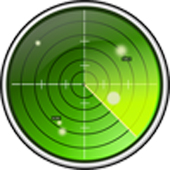Sections
RADAR stands for RAdio Detecting And Ranging. Have you ever imagined how an airplane detects the path or any object in its front on a cloudy day or at night? The answer is using RADAR. Initially RADAR was developed during World War II to spot enemy aircraft and now it is being used in all aircraft, spacecraft, missiles, weather forecasting, in marine to locate ships and prevent collision and so on. RADAR was invented by a Scottish physicist named Robert Watson-Watt (1892–1973).
The working principle of RADAR can be explained in the same way as we see things using a torch at night. When we switch on the torch, the light from it enable us to see the objects. In the same way, RADAR emits high frequency radio waves from its transmitter, hit the object on its path and get bounced back to the radar which is received by the receiver of the radar. Therefore we can define RADAR as a device that uses electromagnetic waves or specifically high frequency radio waves to determine the range, altitude, direction or speed of a fixed or moving object.

The system has got a transmitter section, receiver section and an antenna that acts as both a receiver and a transmitter.
The transmitter produces high frequency radio waves that are emitted into space by the radar antenna. The waves emitted from the transmitter come in contact with the target object and the waves get reflected or back scattered. The target object may be stationary or moving. If the object is moving either toward or away from the transmitter, the frequency of the radio waves change caused by Doppler effect.
The duplexer switches the radar antenna alternately between the transmitter and receiver.
The receiver radar antenna receives the reflected or echo RF signal, demodulate and amplify it to produce video signals on the output.
Radar antenna transfers the high frequency signals into space with the required efficiency as a transmitter and changes to as a receiver with high sensitivity.
The indicator present to the observer the relative position and direction of the target as an easily understandable graphic picture continuously.
It is the most frequently used radar antenna type. It consists of one circular parabolic reflector and a point source situated in the focal point of the reflector. The point source is called as “primary feed” or “feed”. In the parabolic reflector, all reflected rays will be parallel to the axis of the reflector which gives only single reflected ray parallel to the main axis. This radar antenna produces a pencil beam. If the reflector has an elliptical shape, then it will produce a fan beam.
Slot antennas are used in the frequency range from 300MHz to 25GHz. They are used in navigation radar usually as an array fed by a waveguide. Slot antenna has linear polarization. Its fields are similar to dipole antenna but the field components are interchanged with vertical slot having horizontal electric field and vertical dipole has got a vertical electrical field.
The A Scope display presents only the range or the distance to the target and also the relative strength of the echo. They are mainly used in radar systems that control weapons.it uses an electrostatic deflection cathode ray tube. The sweep is produced by applying sawtooth voltage and the time duration of the sawtooth voltage determines the range displayed on the screen.

It presents a 2-D representation of space. The horizontal axis presents the measurement of the bearing or azimuth and the vertical axis presents the measurement of the range. The bearing of a radar target can be defined when referenced to the true north as the angle between true north and a line pointed directly at the target. The angle is measured in the horizontal plane in clockwise direction from true north. B Scope displays were mainly used in airborne and fire control radars in early 1950s.
The PPI (Plan Position Indicator) Scope has a map like picture of the area radiated by the transmitter.It uses a radial sweep about the center of the picture. The center represents the position of the transmitter. It displays all targets for 360 degree. It is also available as sector PPI Scope and it displays all targets within a specific range.

It is a type of radar in which the transmitter emits continuous radio waves of fixed frequency. The two categories of continuous wave radar are: Modulated and Unmodulated CW radar.
It is a type of radar in which the transmitter emits high power, high frequency pulses at the target. The two categories of pulse wave radar are: MTI and pulse Doppler radar.
MILITARY PURPOSES
WEATHER FORECASTING
MARINE FIELDS

Locating pipes and utilities Tunnel wall inspection Mine inspection
The application of radars in day to day life has enormously increased to a great extent that it could even act as a life saver when it was used to search the trapped scores of people in the rubble on 11 September,2001 terrorist attack at the twin tower.
Sections